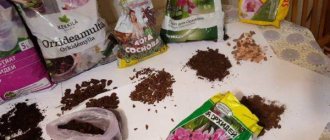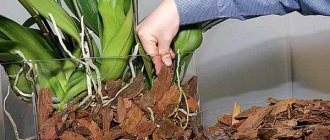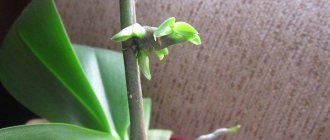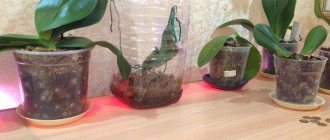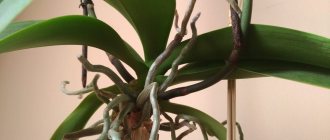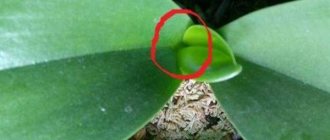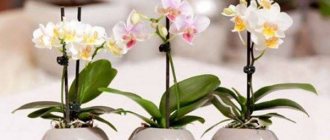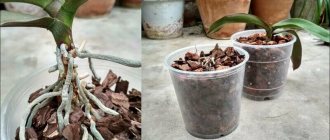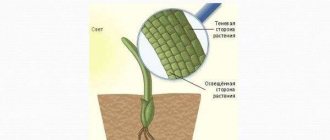Tropical beauties, differing exotic forms and developmental features, have a structure typical of flowering plants:
- They have leaves;
- Stems;
- Roots;
- Flowers.
And the presence of buds is mandatory - the rudiments of any of the plant’s ground organs.
Buds play an important role in the life of orchids:
- Generative ones are responsible for offspring;
- Vegetative ones serve for growth and development;
- But they can also participate in reproduction (adventitious and dormant buds can transform into children).
Below we will tell you everything about orchid buds - various questions and answers to them.
Features of orchid development
The division of orchids according to the type of growth into two groups determines their difference in structure and development features:
- Monopodial species (Phalaenopsis, Vanilla, Vanda, Ascocentrum) are distinguished by the presence of only one crown growth point, which implies the development of the plant straight upward with the constant laying of new leaves and aerial roots along the entire stem. Flower buds form exclusively in the leaf axils. Vegetative side - mostly sleeping, ready to wake up if necessary. These orchids do not have special formations (bulbs, rhizomes), storing nutrients in the leaves;
Monopodial type of orchid. - The sympodial type of branching (in Cattleya, Lelia, Cymbidium, Dendrobium, Odontoglossum) is characterized by the development of the plant in the horizontal plane due to the formation of rhizomes (ground or underground shoots). The buds on them give rise to vertical growth during the growing season, at the end of which the apical growth point dies or, having stopped developing, forms a pseudobulb. Next, new growth is formed due to the lateral development of the primordia at the base of the bulbs. Flower buds appear : Leaves grow from the bud;
- In internodes;
- Or at the base of the shoot.
Orchids are divided into monopodial and sympodial species.
Vegetative method of propagation
How does an orchid bud swell? In home culture, the most acceptable method for propagating tropical beauties is the vegetative (asexual) method , which involves using part of the mother plant. It could be:
- Cuttings;
- Division;
- Formation of lateral layers or children on the peduncle.
The young specimen obtained as a result of such reproduction is genetically completely consistent with the donor orchid .
IMPORTANT! For any method of vegetative propagation, you should choose a sufficiently large and healthy mother plant and ensure that the daughter parts have at least 3 dormant buds.
In sympodial species, the easiest way to propagate is by simply dividing the bush into parts (2-4 pseudobulbs each); for monopodial orchids, cuttings and growing babies are more often suitable.
What does a baby orchid from a bud look like?
Some types of orchids are characterized by the formation of babies from dormant buds at the base of the basal neck or on the peduncle. A baby is a new independent plant in miniature with its own leaves, roots, and sometimes peduncles, attached to the mother specimen.
Most often, a baby is formed on the peduncle of an orchid.
For the full development of a new orchid, the baby must be separated and planted in a separate pot . But this can be done only after it has several leaves (they form first in the baby) and the roots have grown to 4-5 cm. Such a “bush” at the age of six months is ready for replanting.
What is it and what does it look like?
In botany, a bud is the rudiment of a plant part . Usually formed in the leaf axil or on formed organs: stem, roots. The buds are vegetative, from which vegetative shoots appear, respectively, and generative. The latter give birth to flowers or inflorescences and are located in the axils of the leaves (we talked in detail about the structural features of the orchid in this material).
Reference! A bud may appear and then seem to freeze in the process of development. Such formations are called dormant.
What is an orchid bud? The role of meristems in the life of “daughters of the air”
How to grow an orchid from a bud? From a botanical point of view, the buds of orchids, like other plants, are the rudiments of future terrestrial organs. Depending on the internal contents they are divided into :
- Vegetative (future stems and leaves);
- And generative (future inflorescences and single buds).
Each plant must have rudiments :
- Apical (located at the tip of the stem);
- Axillary (hiding at the base of the leaves);
- Accessory (formed on adult parts - shoots, leaves, roots);
- Dormant (frozen in their development until a certain time).
All types of buds have their own specific task :
- Growing up;
- Formation of branches;
- Reproduction;
- Or renewal.
ATTENTION! Dormant buds have a second name - meristem. Their location is in the axils of the leaves and on the flower arrow (lower scaly formations - up to 4 pieces). Each meristem, under different growing conditions of an orchid, is capable of forming a peduncle or child.
Bud - a way to propagate orchids at home
Under natural conditions, orchid buds are responsible mainly for increasing the above-ground part , that is, for the growth of the plant. In the process of reproduction, only generative primordia are involved, forming peduncles and participating in this way in the formation of seeds.
What does a peduncle bud on an orchid look like? In home culture, it is quite difficult to propagate exotic beauties with seeds, so the role of the buds changes dramatically. The orchid shot out from a dormant bud , no longer taking part in sexual reproduction. Under unfavorable conditions for flowering, they can produce babies - and this is their contribution to reproduction.
Babies can form from a bud on an orchid peduncle.
Vegetative buds begin to play the main role in the formation of new plants in home growing conditions . Adnexal buds are capable of producing lateral processes or children on:
- Mature leaves;
- Stems;
- Or roots;
- And also sleeping in the axils of leaves;
- At the basal neck;
- Or buds on flower stalks.
These formations, after a period of maturation on the mother plant, turn into new independent specimens .
The process of propagation by cuttings or division also involves vegetative lateral ocelli , which are forced to wake up to maintain the viability of the orchid. They form new ones:
- Shoots;
- Leaves;
- Kidneys;
- And then the flower stalks.
Meristem - what it looks like
A dormant bud or meristem is a rudiment that has begun to develop and, for some reason, has slowed down this process and fallen asleep .
It looks like a small scaly tubercle at the base of the basal neck or large thickenings on the lower part of the peduncle, covered for protection with dense visors of scales. The meristem can awaken:
- If necessary;
- Or when stimulated.
For an orchid, it plays the role of a guarantor in case of unfavorable conditions .
Interesting! Meristems have an essential reproductive function in the life cycle of orchids. Depending on the specific conditions of caring for the plant, they may form a baby or a peduncle.
It is necessary to cut off the peduncle of an orchid above the dormant bud.
In any of these options, the sleeping eye is involved in reproduction :
- In the vegetative stage - during the formation of a child;
- In sexual - when releasing a flower arrow (in the case of further artificial pollination and obtaining seeds).
Where can meristems form?
In sympodial species of orchids, dormant primordia are located at the base of old pseudobulbs or on peduncles - from them both new rhizomes (rhisomes) and children or peduncles can develop.
In orchids with a monopodial structure, almost all buds are considered meristems . They can be found:
- On the lower part of the peduncle (3-4 pieces closest to the base);
- On the run;
- Or at the base of the basal neck.
The meristem most often forms at the base of the orchid neck.
All of them, in a certain unfavorable situation or under the influence of stimulation, are transformed into a peduncle or baby.
Shoots from a bud - what is it: a peduncle or a baby?
The first time after the new arrow pecks, it is impossible to say with certainty what will grow as a result - a peduncle or a baby. At the very beginning of formation they are quite identical . But after 4 weeks, doubts will disappear by themselves, since the baby’s leaves will begin to develop during this period. If the arrow continues to grow, this is definitely a future peduncle.
But if it is impossible to immediately determine what will grow from the rudiment, then you can try to create favorable conditions for the formation of the organ that is needed. Adjusting the temperature, watering and lighting will help to grow another peduncle or child for reproduction.
What and how to smear?
With all attempts, nothing works. Even following the rules did not produce results; in this case, artificial stimulation of the kidneys cannot be avoided. This technology is based on the use of modern drugs , for example, cytokinin paste. It is made on the basis of phytohormones, which in turn provoke active cell division.
- Before starting the procedure, we disinfect the instruments.
- Then we cut off the non-blooming peduncle, precisely the part on which the buds were attached.
Cut 2 cm above the dormant bud.- We disinfect the cut itself with ground cinnamon.
- Let's move directly to the dormant bud itself.
- Using the tip of a knife, carefully pry it up and then remove the top scale.
- Using a toothpick or needle, evenly treat the lower green bud with cytokinin paste.
- After a couple of months it will become clear whether the baby will grow up.
Next, you can watch a video on how to treat a dormant kidney with cytokinin paste:
Orchids are ancient and unusual plants, in many ways unlike the flowers we are used to. Organs such as the bulb and aerial roots, which they acquired in the process of evolution, help them withstand heat and humidity, as well as obtain nutrition and water literally “from thin air.” Read more about the features of these parts of the plant, as well as why the roots grow upward, in our materials.
Awakening period in natural conditions
How to awaken sleeping orchid buds? Under natural conditions, the life cycle of orchids depends on changes in the tropical climate .
The beginning of the awakening of life in the tropics coincides with the rainy season, when rising temperatures and very high humidity create favorable conditions for the rapid growth and development of all representatives of the flora.
At this moment, the “daughters of air” activate the increase :
- Green mass and root system;
- Meristems also hatch, capable of forming flower shoots or new shoots and children.
The sleeping bud of phalaenopsis awakens in the same way as in the others.
Shade
First of all, it is necessary to organize proper lighting. It is impossible to completely isolate an orchid from sunlight, and it should absolutely not be left in the open sun, since it has very delicate and sensitive leaves, and burns are inevitable. Under natural conditions, orchids grow in diffused light - in the crowns of trees that they entwin.
The best option to help stimulate dormant buds is shading the plant.
Usually, stimulation of dormant buds begins in February - early March. The length of daylight during this period is approximately 10-11 hours. If before this the plant was in a fairly well-lit place, you need to put it on a window on the western or, in extreme cases, the eastern side of the house.
Thanks to this rearrangement, the sun will illuminate the orchid for 5-6 hours a day, which is quite enough to awaken dormant buds.
Direct sunlight can only safely fall on the flower stalks (and not for too long). If you notice that a brown tint has appeared on the flowers, it means that the phalaenopsis is “tanned” and needs to be rearranged. If this is not possible, block the light with tissue paper or tracing paper.
Awakening the buds of orchids at home
For the comfortable well-being of exotic beauties in home culture and to undergo all the processes of their life cycle planned by nature, flower growers need to study all the nuances of orchid growth in the natural environment and try to create a microclimate as close as possible to their natural habitat.
How does a bud appear on an orchid?
Monopodial species of orchids have one apical growth point , due to which the plant increases in height. Every year, during vegetative growth, new pairs of leaves are formed, in the axils of which meristems are laid. They may eventually develop into a peduncle or shoot. At the same time, lateral vegetative buds are formed on the trunk, producing young children in the future if necessary.
A bud forms on an orchid during vegetative growth.
In sympodial species, bud formation also occurs annually during the active phase of plant growth. Generative rudiments are formed:
- At the base of the shoot;
- At internodes;
- Or in the axils of leaves.
Vegetative ones are located on the lateral surfaces of rhizomes and give rise to new shoots and then pseudobulbs.
Important! Thus, the appearance of new eyes on orchids occurs constantly in regular cycles.
During what period is the greatest likelihood of a kidney appearing?
Under natural conditions, all life processes, including the formation of generative and vegetative rudiments, begin with the onset of favorable conditions for tropical beauties. According to the same laws, the life cycles of orchids in home culture occur.
In the spring, after a winter period of dormancy (in species with a full development cycle) or a short rest from flowering (in species without winter dormancy), when comfortable temperature and light conditions occur, orchids begin active growth and development , including laying new rudiments of future peduncles or processes.
Stimulating the awakening of the kidney at home
The kidneys have frozen and are not growing, how can I stimulate them? At home, the meristem can spontaneously wake up and form a peduncle or a new shoot - a baby. But if the conditions of care meet the requirements of the orchid and it feels great, then you may not wait for the awakening of the meristems for several years.
In this case, if you want to get a new arrow or start propagating your favorite flower with the help of children, you should stimulate the kidney . Depending on the desired result, the conditions for stimulation vary greatly. What do dormant buds look like? You can see this in the photo below.
When favorable conditions are created, the orchid's bud will open on its own.
To stimulate awakening in order to obtain offspring, it is necessary to create suitable conditions :
- Reduce the illumination of the plant by moving it to a shaded place;
- Maintain air humidity within 60%;
- Ensuring a difference between day and night temperatures within 10 degrees, but not lowering the daytime temperature below 25 degrees is an indispensable condition for awakening the vegetative, rather than floral, meristem;
- Reduce watering to a minimum, while fertilizing with nitrogen fertilizers (nitrogen increases the growth of greenery and makes flowering more difficult);
- Spray the orchid at least 5 times a day.
ADVICE! To awaken the meristem in order to produce babies, you should increase watering with mineral fertilizers every once in a while.
When optimal conditions are created, the plant can respond to the efforts of the grower and form a long-awaited baby from the awakened meristem.
To stimulate in order to obtain a peduncle, slightly different conditions are created :
- The temperature difference during the day should be maintained at about 6 degrees, but during the day the thermometer readings should not exceed 25 degrees - otherwise conditions will be created for the development of the baby;
- Reduce watering as much as possible until almost complete drought;
- An indispensable condition is to rest the plant for several months after the previous flowering;
- If the stimulation process falls in the autumn months, it is necessary to organize artificial lighting.
These conditions can help the orchid form another new peduncle , but if the previous flower arrow was completely removed, then the waiting time for flowering may be prolonged.
Optimal wake-up conditions
How to awaken sleeping kidneys? Is it possible to water an orchid when a bud appears? can be considered sufficient conditions for the awakening of the vegetative meristem :
- Weak watering;
- Sufficient shading;
- High temperatures (at least 25 degrees) combined with daily fluctuations;
- And increased doses of nitrogen fertilizers.
mode for awakening the generative bud :
- With increased lighting;
- Temperature no more than 25 degrees and daily fluctuations;
- As well as reducing watering for a stress push.
In any case, the orchid to be stimulated must be :
- Rested after flowering;
- Adult (over 3 years old);
- Healthy;
- With a strong root system;
- And at least 4 leaves.
Stimulation drugs
How to propagate an orchid, what to smear the bud with? If experiments to stimulate the awakening of meristems fail, flower growers use special preparations that increase the possibility of the appearance of peduncles or shoots. The best in this regard is considered to be hormonal cytokinin paste with essential vitamins. The main consequence of using the paste is the acceleration of cell division.
Cytokinin paste for awakening helps:
- Awaken the meristems;
- Form generative buds;
- Speed up the process of preparing for flowering;
- Form shoots in the required place.
To stimulate the buds of an orchid, cytokinin paste is often used.
Using the paste can create a small miracle - forming a new bud where there should not be one.
Application of cytokinin paste
Few people know the name of the ointment for stimulating the kidneys. The process of working with hormonal paste is not difficult . First you need to choose a suitable kidney. Next, use a sharp knife to remove the protective scales, having first carefully cut them on the sides.
under the scales is a small green formation , onto which, using a thin stick or toothpick, you need to apply the required amount of paste and easily distribute it over the entire area. Results can be expected in a week or 10 days.
CAREFULLY! Do not use cytokinin paste on young or small specimens, on apical shoots with leaves and roots - the orchid may suffer or die.
When using paste, you should adjust the volume applied to the object:
- To obtain a peduncle, a very small dose is needed;
- A large amount of paste will lead to the formation of a baby.
Many gardeners use cytokinin ointment to awaken the buds.
Is it possible to wake up and is it necessary to do this?
If you want to get a new shoot - baby - or peduncle, you need to stimulate the orchid, because
under favorable conditions, the kidneys may freeze and not develop. If you intend to artificially help a flower produce offspring, you first need to understand the conditions under which the orchid reproduces in nature. The process of awakening the kidneys begins in the wild during the rainy season. At this time, the orchid accumulates moisture, absorbs necessary nutrients and accumulates strength to create offspring. At home, it is necessary to create conditions as close to natural as possible.
The appearance of a bud on an orchid peduncle
Buds appeared on the stick: what to do and how to care for it? The lower buds on the peduncle (usually 4 pieces, closest to the base of the arrow) are meristems , from which it is possible to peck a peduncle or vegetative shoot for reproduction. You can see a photo of a bud on a peduncle below.
The bud that appears on the peduncle is called a meristem.
The upper ones are responsible for the formation of inflorescences. When a bud appears on a peduncle, it is not immediately clear what it is.
New peduncle or baby?
The first month after the awakening of the meristem does not answer the question : what will grow as a result - a baby for reproduction or a peduncle with beautiful flowers? Both rudiments are very similar to each other. But as the new formation grows, it becomes clear which way the scales are tipped.
After about 4 weeks, the first leaves begin to form . If the shoot continues to increase in length without giving any branches, it means that a future peduncle is developing from the bud.
How long does an orchid's peduncle grow before it blooms?
The development period of each peduncle depends on many factors . The determining factor is the type of orchid - the ripening time of the peduncle varies among different species. For Phalaenopsis, this time takes approximately 2 months.
The duration of this period is significantly influenced by the conditions for caring for the plant . Optimal indicators reduce the time of formation of the peduncle until flowering. The main thing is to have good lighting: the more light, the shorter this period.
How to properly trim a peduncle to a dormant bud
behaves differently in each specimen . If the peduncle turns yellow and dries out, it should be removed after complete drying. If the arrow has dried only halfway, this means that the plant needs rest, it does not have enough strength to bloom again - the peduncle must be cut off completely. But if the arrow remains green after the end of flowering, then this is a sign of the possible formation of further flower stalks or children in the near future.
In the latter case, the arrow can be left alone , but partial trimming can be done. For the procedure, a disinfected pruner is used, which is less harmful to the plant than other tools. The peduncle is trimmed, leaving a third of the length for future flowering. The cut is made above the dormant bud, maintaining about 2.5 cm of shoot before it - otherwise there is a possibility of the meristem drying out.
How to grow a baby from a peduncle
How does a baby orchid bud appear? If it is necessary to trim the green peduncle (if the weakened orchid is given rest), it can be used to form children by cuttings . To do this, the cut arrow is divided into parts (about 4 cm) so that there is a healthy bud in the center of the cutting. The ends are disinfected with activated carbon.
The baby is grown on a peduncle using cuttings.
The finished cuttings are placed in containers with water in the light or placed in a greenhouse on damp moss . The babies are expected to arrive in about a month.
The children formed on the cuttings should produce leaves and several roots up to 4 cm in length. After this they are ready for transplantation:
- The remains of the mother shoot are cut off on both sides, leaving small stumps;
- And they put the baby in a suitable (not too large) pot.
If the baby is formed on a growing peduncle, the transplantation steps are identical to planting babies from cuttings. After transplanting, the pots with the babies are placed in a shaded, warm place for several weeks for the acclimatization period.
Instead of watering, spraying is used. Then care for new specimens according to the standard rules for this species.
But if a baby is formed on a shoot (basal), it cannot be replanted . Such a baby does not form its own roots and feeds on the mother plant. Separating and planting will certainly kill such a baby. It is advisable to leave it on the shoot - eventually the mother plant will die off, leaving a new specimen.
Orchid bud transplant and aftercare
The disadvantage of vegetative division is the small number of specimens obtained. To grow new orchids on an industrial scale, a method of meristem propagation or isolated bud culture was invented. In this option, individual buds or tissue particles are used: they are deposited on a nutrient medium in sterile boxes. After the children are formed, the method of transplanting and caring for young orchids is standard.
For use in amateur floriculture, this method is complex and time-consuming, but experiments are already being carried out . To achieve good results, the buds should be chosen correctly: the best ones are located closer to the base.
How to make phalaenopsis bloom by stimulating the buds in a greenhouse
First way. This method is similar to cuttings. The faded peduncle is cut off at the base and wiped with alcohol (50%).
Then, using a sharp blade and tweezers, remove the covering scales from the phalaenopsis buds and cut it into short pieces of 3-4 cm with the buds in the middle. How many buds - so many parts.
All cuts are treated with cinnamon or charcoal.
Harvesting cuttings
Next, take a transparent container with a lid, sterilize it and make a greenhouse out of it filled with damp sphagnum moss, after soaking it in distilled or boiled water and squeezing it out.
Prepared fragments of the peduncle are laid out (horizontally) on the sphagnum moss and covered with a lid.
The container is placed in a bright and warm (+25-30°C) place. As the moss dries, you can water it, or even better, lightly sprinkle it with water so as not to create a swamp.
The process of the appearance of a baby orchid can be very long, but increased humidity and temperature will eventually do their job. During the experiment, some of the cuttings may die.
Rooted peduncle stalk
There is another option for propagating orchids using peduncle cuttings in a plastic bottle. The cuttings are placed not horizontally, but vertically.
For this, a special greenhouse is built from 2 plastic bottles. Holes are made in one top. Pieces of cotton wool are used to secure the cuttings in the holes so that they do not fall.
When the orchid cuttings already have babies, they can be transplanted into crushed pine bark. And if suddenly one of the cuttings turns yellow, you will need to cut it off, dry the baby, process the cuts and place it back.
Second way. You don’t have to cut the peduncle, but simply place it in a container filled with damp vermiculite or in a bottle with filtered or boiled water 4-7 cm high.
You can use complex mineral fertilizer, diluting it in water - the effect will be much better.
Rooting in vermiculite
If you use a regular plastic bottle, you can simply close it with a lid and place it in a warm, lit place. Remember that the higher the mark on the thermometer (from +25°C and above), the more likely the appearance of phalaenopsis babies.
If you place the peduncle in an open vase, you can cover it with a transparent plastic bag on top.
Orchid diseases and their treatment
If mold appears on the lower tip (closer to the surface), it is washed with warm water and the water is replaced with fresh water. If not only mold has appeared, but also a small area has become soft, this area is cut off.
Buds on the roots
Some orchids have the ability to reproduce by basal children , forming buds on the roots.
Sometimes a bud can grow on the root of an orchid.
This phenomenon occurs when the apical point of growth is damaged and serves as protection for the plant. In addition, basal children are formed in plants that have produced a peduncle from the growing point.
Is it possible to transplant such a kidney?
The children formed from the root buds are tightly connected to the mother plant . If the pot is large enough for two plants and both plants are doing well, then it is advisable to leave the baby in place.
If absolutely necessary, the baby can be carefully separated from the mother plant , but only if the root system of the young orchid has sufficiently grown. When replanting, you should be extremely careful with the roots of both the adult plant and the baby.
How to separate a root bud without ruining the plant
To separate the root children, the greatest care is required with the root system. First of all, determine whether the roots of the baby have grown by removing the top substrate from the pot. Then the roots are cleared of soil. Branch location first:
- Marked with a knife 1 cm from the baby;
- The root is cut;
- The young plant is freed.
After the procedure, both plants are treated with activated carbon and slightly dried before planting. All instruments must also be disinfected.
The most favorable time for transplantation
A favorable time for transplantation is considered to be the beginning of spring , when active vegetative growth has not begun, the plant has rested after winter and is full of strength. But if the child requiring transplantation does not have sufficiently developed roots, then the operation should be postponed until a later time.
Are there buds on aerial roots? What to do with them?
The aerial roots of an orchid are the same root system, the only difference is in the thickness of the protective layer of velamen. Very rarely, aerial roots can produce a basal child from a bud at the base in the same way as the main roots. The principle of working with such children is identical to working with rudiments on other parts of the plant. It’s not often that you see a bud appear on an aerial root, which then sprouts leaves.
Why is it important to distinguish the arrow from other parts?
A new root, baby or peduncle foreshadows the lush bloom of the orchid. Every flower lover should be able to distinguish the peduncle from other parts.
It is important to:
- Prevent flowering of a plant that has survived planting or disease. The shoot is cut off to give it strength to grow.
- Observe the development of the orchid.
- Understand how to properly care for an orchid during the flowering period.
If the plant produces a healthy leaf and peduncle at the same time, it must be given the opportunity for further development.
What does it look like?
The peduncle changes greatly during its life cycle. There are two types: new and old. A young shoot grows from the place where the leaf comes close to the stem - from the axil.
This peduncle is different:
- Rich light green or green color.
- Growing up or sideways towards the sun.
- Flat shape with a pointed end in a stepped shape.
Scales can be seen on the young peduncle. From the moment the arrow begins to grow until the buds open, it will take about 2 months (what to do if the peduncle does not appear?).
Over time, the flowering arrow will develop and turn into a juicy, long and flexible stem. Buds will bloom on it.
When the orchid's flowering period has passed, the appearance of the peduncle will change: the green color will change to yellow-brown. Sometimes bright purple and red colors are observed.
Then the old bud dries out and falls off. It is advisable not to allow this to happen, but to prune the shoot after the last flower has withered. This measure will help keep the plant strong.
You should pay attention to the tip of the peduncle. It is often difficult to understand whether flowering time has passed
If the bud is green, it can grow and put out buds. When the tip turns yellow, black or dry, the flowering period is over.
Each gardener decides for himself whether to cut or leave the peduncle. Old shoots weaken the plant and delay the development of new shoots. But the old peduncle can form children or bloom again. Read more about what to do with the peduncle when the orchid has bloomed here.
How to distinguish from root and baby?
An orchid's newly appeared arrow can easily be mistaken for a root or a baby.
The peduncle has a number of distinctive features:
- It grows from the leaf axil of a fresh leaf.
- The sharp end has a complex stepped shape, like a cone. Resembles a closed beak.
- Directed upward, sometimes sideways.
The peduncle will begin to descend only under the weight of the formed buds.
The root usually grows next to others - under the leaves at the base of the trunk. But it can also appear in an unexpected place - break through the leaves. The root has a round, smooth, blunt shape and no scales. As it grows, the difference between the tip and the rest of the root will become noticeable. It will be gray or gray-green, and the end will be bright - light green or green. The root bud can grow in any direction, but is usually directed downward.
Peduncles and roots are slightly similar only in the initial stage of development. Upon careful analysis, it will become clear that they are completely different. One fact will unite both parts of the plant - during germination, they seem to break through the leaf.
It is almost impossible to immediately determine whether a flower-bearing arrow or a baby has appeared on an orchid.
At the initial stage of development, the neoplasms are visually similar: the same shape, the presence of scales. When the process grows by 3 centimeters, conclusions can be drawn based on its shape.
What the new baby looks like:
- Pointed upward.
- The shape of the tip resembles an open beak.
- It grows in the place of a flowering shoot.
The appearance of a baby (including a root baby) is preceded by a complete absence of a growth point. Instead of a leaf, there is an arrow from the top. Moreover, the orchid is quite old - more than 6 years.
The baby has a number of differences from the peduncle:
- Very small scales that hardly develop during growth.
- After two weeks, the arrow grows and produces leaves.
- As the process develops, a depression forms in the middle.
The ability to immediately recognize new growths on an orchid will come with experience.
We invite you to watch a video on how to distinguish an orchid peduncle from roots and children:
The orchid's bud woke up on its own - what to do?
If the apical (outmost on the peduncle) bud of a flowering orchid unexpectedly awakens, then flowering will continue and several smaller flowers will additionally appear. You should not touch the peduncle unless there is a danger of weakening the plant.
If a bud appears suddenly, it is not recommended to touch it unless it harms the orchid.
The bud under the flower closest to the base of the arrow (lateral) may wake up on its own - cut off the inflorescence , retreating 3 cm from the hatched bud, from which a new peduncle or baby will then grow. But you can let the orchid bloom and only then cut off the remains of the inflorescence.
Possible problems and their solutions
It happens that the peduncle either grows somehow “wrongly” or is completely absent.
Unfortunately, injury to the plant is also possible when the arrow breaks. For beginners, such emergency situations cause a lot of anxiety.
There's no need to panic. Let's look at each of these cases and consider what the gardener should do.
Emergence from the growth point
The arrow grows from the growing point - this happens with elderly phalaenopsis that have survived many flowering cycles. Another reason is severe stress experienced by the plant. This is the same case when the owner of the plant does not need to do anything. Just take care of your pet as usual. Perhaps the arrow will still produce buds or a baby.
The flowering shoot is broken
What to do? Simply cut the peduncle to the bud closest to the fracture site, and treat the cut area with activated carbon or cinnamon powder. Under no circumstances try to connect the fragments with tape or tape, as some inexperienced amateurs try to do, in the hope that their orchid will “grow together.” This will only harm the plant; it may begin to dry out!
Absent at all
What should the owner of a “lazy” phalaenopsis do, how can he still grow a peduncle? If the plant is in no hurry to shoot out its arrows, you can give it a little shake-up - place it in a darker place than usual and water it less often than before (of course, without leading to complete drought). If possible, it is better to lower the temperature for phalaenopsis by 5-6 degrees at night. Experienced gardeners make plants that have been dormant for even a year or more bloom in this way.
Stuck in development
It happens that the peduncle grows to a sufficient length and even produces several buds, and then suddenly stops its growth.
If phalaenopsis stops growing, algorithm of actions:
- First of all, you should make sure that the orchid is healthy. Perhaps the reason is some kind of disease or pest.
- Analyze the conditions of keeping your phalaenopsis - does it have enough light, is the humidity and temperature regime observed, does it have enough feeding?
- If, after treatment and the establishment of optimal conditions, the peduncle continues to remain frozen, the most reasonable thing is to take a wait-and-see approach and watch the arrow. If it hasn’t dried out, there is a chance that your green friend will someday please you with flowers.
You can learn more about the main reasons for the lack of flowering of phalaenopsis here, and from this article you will learn how to make an orchid bloom at home.
Is it possible to replant a plant with buds? Nuances
How is a kidney transplant performed, how to care for an orchid? For any plant that is preparing to flower, replanting is contraindicated. But there are emergency situations (the plant is sick, the roots have begun to rot, the flower has grown greatly) when the orchid needs help and it is impossible to wait for the end of flowering. Then the transplant is carried out, observing the nuances :
- When the roots rot, the peduncle is cut off; in other cases, it is advisable to shorten it a little;
- The roots are cleaned of the substrate, damage is trimmed, disinfected and dried;
- The remaining procedures are carried out according to the standard plan with extreme caution;
- After transplantation, place in a warm place with good lighting and do not water for several days.
If not properly cared for, the orchid's buds dry out.
Orchid care before and during flowering
Before the peduncle appears on the phalaenopsis, you need to follow simple rules:
- provide sufficient but diffuse lighting (avoid the south side of the premises);
- water the plant regularly (do this only after the top layer of soil has dried);
- place the flower pot in a well-ventilated room, but so that there is no draft;
- It is necessary to moisturize not only the soil, but also the air around the phalaenopsis;
- Feeding an orchid should be regular, comprehensive and complete.
When the flower arrow appears on the horizon, you will need to slightly change the conditions for keeping the plant. To do this, change:
- Location. If the flower stalk emerges in mid-autumn or at any time in winter or spring, place the flowerpot with a pot on the south side of the room. Don’t be afraid, during these periods the sun is no longer so hot and will not harm the flower.
- Watering mode. It needs to be shortened a little. But you have to look at the situation. Ingod only needs to be watered once every two weeks (compared to the fact that before this you watered once every seven days).
- Feeding mode. As soon as the flower arrow appears, you will need to reduce the volume and frequency of fertilizer application, but only slightly. But after the peduncle has already strengthened and grown, and swelling buds begin to appear on it, the feeding process must be completed. The fact is that the abundance of fertilizers will not in any way affect the number of flower buds. Their number is laid down at the stage of formation of the peduncle itself.
Why do the buds turn yellow, dry out and fall off?
With proper care, the orchid forms buds and blooms for several weeks. All problems with the kidneys (except for age-related changes - after 5 years, orchids bloom reluctantly) occur due to violations of the care regimen . Bud fall is possible when:
- Excessive watering;
- Violation of temperature readings in any direction;
- Lack of lighting;
- Or from drafts.
To save the situation, all conditions for keeping the tropical beauty should be normalized.
Orchids, for the most part, very easily adapt to specific living conditions , and respond to care with active growth and abundant flowering. Knowledge about the developmental features of an exotic plant and the role of buds in its life cycle can help flower growers create more comfortable conditions for the “daughters of the air.” All you have to do is stick to routines and schedules and love your tropical guest.
Step-by-step instructions: how to grow?
You can make sure that this is definitely a peduncle stalk when it grows to 10 cm and takes shape. After this, fix it in a vertical position and continue to care, following the recommendations given earlier. This is necessary to obtain an even and beautiful stem. It is recommended to fix the peduncle in the following ways:
- Secure it to a support placed in a pot. Using a special clothespin, purchased in a store or made from fishing line, or a hair elastic.
- Without support. The peduncle reaches towards the light source. Rotate the container with the plant, thereby setting the direction of growth.
Video on how to secure an orchid peduncle:
What determines the duration and frequency of the appearance of buds?
The duration and time of flowering are directly related to the genetic characteristics of the species. In addition, flower care is a fundamental factor.
Proper watering, fertilizing, lighting and temperature conditions are important here. Failure to comply with at least one of these requirements is enough to reduce the duration of orchid flowering or stop it altogether.
An equally important role is assigned to the state of the plant: how much it has managed to get stronger after it was separated from the mother plant or the previous flowering. If all the conditions for caring for a faded orchid have been met correctly, then you can see the next phalaenopsis bloom in 3-6 months.
What is required for the appearance of phalaenopsis babies?
First you need to figure out where and when the babies of new plants appear, then try to stimulate their development. In healthy and well-developed phalaenopsis, peduncles appear under the old leaves, on which there are buds and two types of dormant buds. Young peduncles are formed from the buds of the first type, and children appear from the second. For them to begin to develop, certain conditions are needed:
- the orchid is mature, healthy, with a strong root system and at least four large leaves;
- flowering has ended, a strong healthy peduncle remains;
- air humidity – high;
- time of year – spring or early summer.
If the humidity is low, you should not expect babies to appear; in the fall or winter, if there is insufficient lighting, you cannot count on normal development. Even in warmth and high humidity, phalaenopsis do not want to reproduce in room conditions. This process needs to be stimulated.

